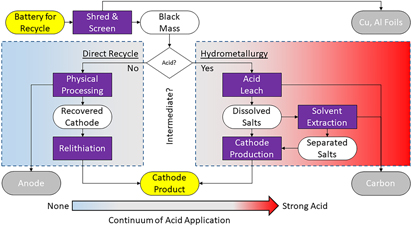Crossref Citations
This article has been cited by the following publications. This list is generated based on data provided by
Crossref.
Gaines, Linda
2019.
Profitable Recycling of Low-Cobalt Lithium-Ion Batteries Will Depend on New Process Developments.
One Earth,
Vol. 1,
Issue. 4,
p.
413.
Rosendahl, Knut Einar
and
Rubiano, Diana Roa
2019.
How Effective is Lithium Recycling as a Remedy for Resource Scarcity?.
Environmental and Resource Economics,
Vol. 74,
Issue. 3,
p.
985.
Larouche, François
Tedjar, Farouk
Amouzegar, Kamyab
Houlachi, Georges
Bouchard, Patrick
Demopoulos, George P.
and
Zaghib, Karim
2020.
Progress and Status of Hydrometallurgical and Direct Recycling of Li-Ion Batteries and Beyond.
Materials,
Vol. 13,
Issue. 3,
p.
801.
Bai, Yaocai
Muralidharan, Nitin
Li, Jianlin
Essehli, Rachid
and
Belharouak, Ilias
2020.
Sustainable Direct Recycling of Lithium‐Ion Batteries via Solvent Recovery of Electrode Materials.
ChemSusChem,
Vol. 13,
Issue. 21,
p.
5664.
Chitre, Aniket
Freake, Daniel
Lander, Laura
Edge, Jacqueline
and
Titirici, Maria‐Magdalena
2020.
Towards a More Sustainable Lithium‐Ion Battery Future: Recycling LIBs from Electric Vehicles.
Batteries & Supercaps,
Vol. 3,
Issue. 11,
p.
1126.
Bai, Yaocai
Muralidharan, Nitin
Sun, Yang-Kook
Passerini, Stefano
Stanley Whittingham, M.
and
Belharouak, Ilias
2020.
Energy and environmental aspects in recycling lithium-ion batteries: Concept of Battery Identity Global Passport.
Materials Today,
Vol. 41,
Issue. ,
p.
304.
Mossali, Elena
Picone, Nicoletta
Gentilini, Luca
Rodrìguez, Olga
Pérez, Juan Manuel
and
Colledani, Marcello
2020.
Lithium-ion batteries towards circular economy: A literature review of opportunities and issues of recycling treatments.
Journal of Environmental Management,
Vol. 264,
Issue. ,
p.
110500.
Beaudet, Alexandre
Larouche, François
Amouzegar, Kamyab
Bouchard, Patrick
and
Zaghib, Karim
2020.
Key Challenges and Opportunities for Recycling Electric Vehicle Battery Materials.
Sustainability,
Vol. 12,
Issue. 14,
p.
5837.
Anwar, Sadia
Zia, Muhammad Yousuf Irfan
Rashid, Muhammad
Rubens, Gerardo Zarazua de
and
Enevoldsen, Peter
2020.
Towards Ferry Electrification in the Maritime Sector.
Energies,
Vol. 13,
Issue. 24,
p.
6506.
Bai, Yaocai
Hawley, W. Blake
Jafta, Charl J.
Muralidharan, Nitin
Polzin, Bryant J.
and
Belharouak, Ilias
2020.
Sustainable recycling of cathode scraps via Cyrene-based separation.
Sustainable Materials and Technologies,
Vol. 25,
Issue. ,
p.
e00202.
Albertsen, Levke
Richter, Jessika Luth
Peck, Philip
Dalhammar, Carl
and
Plepys, Andrius
2021.
Circular business models for electric vehicle lithium-ion batteries: An analysis of current practices of vehicle manufacturers and policies in the EU.
Resources, Conservation and Recycling,
Vol. 172,
Issue. ,
p.
105658.
Yang, Yue
Okonkwo, Emenike G.
Huang, Guoyong
Xu, Shengming
Sun, Wei
and
He, Yinghe
2021.
On the sustainability of lithium ion battery industry – A review and perspective.
Energy Storage Materials,
Vol. 36,
Issue. ,
p.
186.
Cong, Liang
Liu, Weiwei
Kong, Shuai
Li, Honglei
Deng, Yelin
and
Ma, Huazheng
2021.
End-of-Use Management of Spent Lithium-Ion Batteries From Sustainability Perspective: A Review.
Journal of Manufacturing Science and Engineering,
Vol. 143,
Issue. 10,
Makuza, Brian
Tian, Qinghua
Guo, Xueyi
Chattopadhyay, Kinnor
and
Yu, Dawei
2021.
Pyrometallurgical options for recycling spent lithium-ion batteries: A comprehensive review.
Journal of Power Sources,
Vol. 491,
Issue. ,
p.
229622.
Tanhaei, Mohammad
Beiramzadeh, Zahra
Kholghi Eshkalak, Saeideh
and
Katal, Reza
2021.
Handbook of Solid Waste Management.
p.
1.
Huang, Kevin J.
Ceder, Gerbrand
and
Olivetti, Elsa A.
2021.
Manufacturing scalability implications of materials choice in inorganic solid-state batteries.
Joule,
Vol. 5,
Issue. 3,
p.
564.
Wang, Shuoyao
and
Yu, Jeongsoo
2021.
A comparative life cycle assessment on lithium-ion battery: Case study on electric vehicle battery in China considering battery evolution.
Waste Management & Research: The Journal for a Sustainable Circular Economy,
Vol. 39,
Issue. 1,
p.
156.
Yu, Dawei
Huang, Zhu
Makuza, Brian
Guo, Xueyi
and
Tian, Qinghua
2021.
Pretreatment options for the recycling of spent lithium-ion batteries: A comprehensive review.
Minerals Engineering,
Vol. 173,
Issue. ,
p.
107218.
Nciri, Nader
Kim, Namho
and
Cho, Namjun
2021.
Spent Graphite from End-of-Life Lithium-Ion Batteries (LIBs) as a Promising Nanoadditive to Boost Road Pavement Performance.
Materials,
Vol. 14,
Issue. 24,
p.
7908.
Tokoro, Chiharu
Lim, Soowon
Teruya, Kaito
Kondo, Masataka
Mochidzuki, Kazuhiro
Namihira, Takao
and
Kikuchi, Yasunori
2021.
Separation of cathode particles and aluminum current foil in Lithium-Ion battery by high-voltage pulsed discharge Part I: Experimental investigation.
Waste Management,
Vol. 125,
Issue. ,
p.
58.





